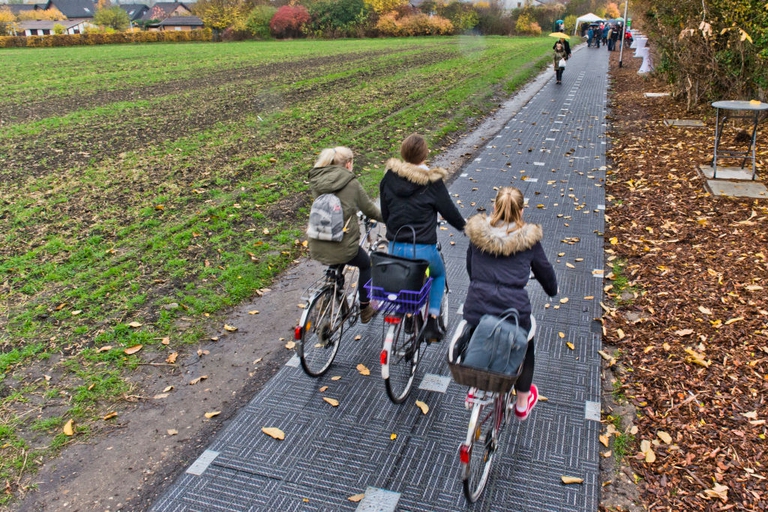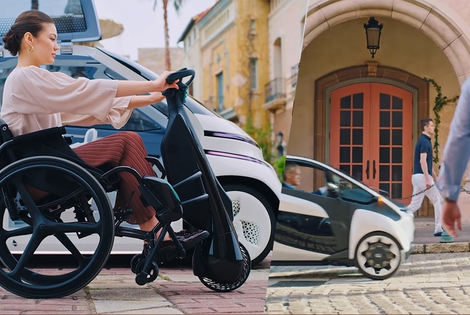
Milan has announced one of Europe’s most ambitious mobility schemes, known as Strade Aperte (open roads). Its goal is to reduce cars in phase 2 of the lockdown by increasing bike lanes and pedestrian areas.
Germany’s first solar bicycle lane could be the prototype for the roads of the future. The photovoltaic tiles melt snow and ice, and are capable of absorbing noise.
Germany inaugurated its first solar cycle lane in November. A 90-metre track made up of 150 solar modules that look like cobblestones located in Erftstadt, in the south-western part of the city of Koln.
Some of the characteristics of this bicycle lane are that it’s capable of reducing noise as well as melting snow and ice, which limits maintenance costs especially during the winter. According to Donald Muller-Judex, creator of this ambitious project, every square metre costs approximately 250 euros: the Erftstadt bei Koln cycling lane cost just shy of 50,000 euros.
The short course created with photovoltaic tiles will be able to provide the local electricity network with a stunning 16,000 kilowatts a year, that is to say 80 for every square metre of the 200 that make up the Erftstadt cycling lane.
The photovoltaic tiles are made with a dark blue glass so durable that it can withstand the weight of a truck, whilst their peculiar structure will prevent bicycles from slipping as they cross the tiles. This means that this technology could be applied to roads and motorways in the future: calculations made by the company Solmove predict that if German roads were covered with solar tiles they could generate the energy needed to power 20 million electric cars.
Solmove presents #solarroads at the @Tagesspiegel event: watch the video (GERMAN) here: https://t.co/vrKqXBceMA
— Solmove (@Solmove1) 9 maggio 2018
This could be a historic innovation if it’s made to coincide with other technological advancements like recharging batteries through induction, putting sensors in the cells of solar tiles to measure traffic flows and optimise traffic lights, all the way to the organisation of traffic by using autonomous vehicles.
This bike lane close to Koln also plays a political role, since it’s approximately a half hour drive from the Hambach forest. This is the area protected by activists who, at one point, were living in the trees to prevent them from being chopped down for the expansion of coal extraction. The 90-metre-long photovoltaic lane in Erfstadt could pave the way for solar technology applied to bicycle lanes, roads and roofs, becoming an alternative energy source to the lignite from Hambach forest.
Siamo anche su WhatsApp. Segui il canale ufficiale LifeGate per restare aggiornata, aggiornato sulle ultime notizie e sulle nostre attività.
![]()
Quest'opera è distribuita con Licenza Creative Commons Attribuzione - Non commerciale - Non opere derivate 4.0 Internazionale.
Milan has announced one of Europe’s most ambitious mobility schemes, known as Strade Aperte (open roads). Its goal is to reduce cars in phase 2 of the lockdown by increasing bike lanes and pedestrian areas.
Formula 1, the world’s most important auto racing championship, has decided to turn the page and aim for carbon neutrality with the support of its teams, drivers and the whole racing circus.
Toyota and LifeGate began telling the story of hybrid mobility back in 2006, now, on the road to the Tokyo 2020 Olympics, they’re still treading the path of sustainable mobility. Here are the main steps of the journey.
The Vespa is back in an electric version. Production has just started and the first models can be reserved online starting from October.
The city of Utrecht, in the Netherlands, is home to a bridge for cycling and walking that stretches over roof garden of a Montessori school. This project enhances practicality and will allow families to bring children to school by bike, passing through green areas. Despite their functionality, bridges are often seen as an infrastructure that is
The Lego hair bike helmet is the latest Internet craze. For now it’s just a prototype but production on a large scale will probably start soon.
Just as fires often give way to new growth, after the Dieselgate scandal, which saw Volkswagen cheating on US emission rules, the German car manufacturer radically changed course, beginning to focus on sustainable mobility. The German car company aims to propose thirty zero-emission models and produce at least one million battery electric vehicles by 2025. An ambitious mission
Sustainable, two-wheel mobility is triumphing in Copenhagen. After years of investments, policies, and infrastructural changes, bikes now outnumber cars in the city centre. The website Copenhagenize has released data linked to the number of vehicles entering the city centre, which are monitored by the city’s administration on a daily basis. Last year, 265,700 bikes have entered
A luminous cycling strip has recently been unveiled in Poland: created in the town of Lidzbark Warminski, the cycling lane glows blue at night, a feast for the eyes. Features of the bike path The lane is divided into two sections – one for cyclists, one for pedestrians – so that everybody can enjoy such








